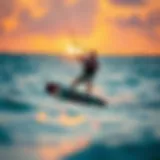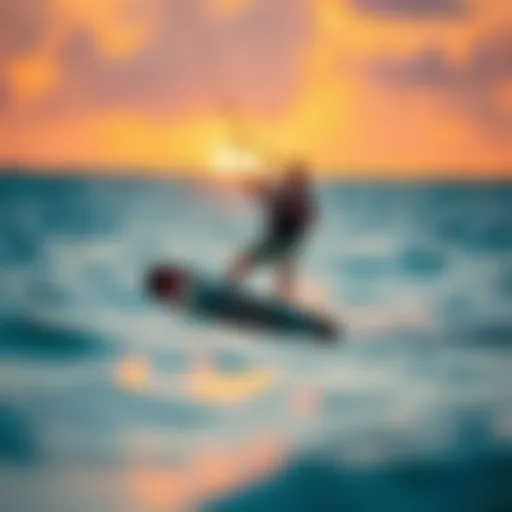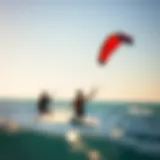Exploring Foilboard Kitesurfing: A Comprehensive Overview
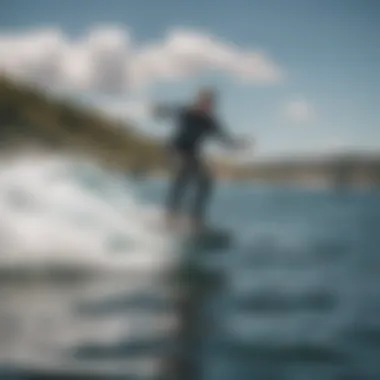

Intro
Foilboard kitesurfing has carved its own niche within the broader kiteboarding scene. It's more than just a trend; it's a radical transformation that elevates the way enthusiasts ride the waves. Traditional kiteboarders know the thrill of dance along the water's surface, but foilboarding takes that excitement to a new level—literally. By utilizing a hydrofoil, riders can glide above the water, experiencing a unique sensation often described as flying.
As this sport continues to surge in popularity, both seasoned kiteboarders and newcomers are keen to grasp the intricacies involved. In this article, we journey through the essential components of foilboard kitesurfing, delving into gear selections, mastering techniques, and understanding the environmental conditions conducive to this exhilarating pastime. Whether you're a seasoned pro or just looking to dip your toes in, we'll provide you the tools and insights needed for a rewarding experience.
Hold onto your kite—let's explore the world of foilboarding about to unfold!
Prologue to Foilboard Kitesurfing
Diving into the world of foilboard kitesurfing opens up a realm that truly transforms the experience of riding over water. Unlike traditional kiteboarding, which sticks to a more conventional surfboard, foilboarding utilizes a unique setup that allows riders to elevate above the surface, gliding effortlessly with the counterforce of water beneath. This not only enhances the feeling of speed but also changes the dynamics involving the wind and waves.
Definition and Fundamentals
Foilboard kitesurfing involves riding a board mounted with a foil, a hydrofoil specifically designed to lift the board above water. This elevates the rider, creating a smoother ride even in choppy conditions. The essence of this sport lies in its sophisticated blend of mechanics and rider control, which can be quite liberating once mastered. What’s intriguing is how the hydrofoil maximizes speed, allowing for performance even when wind power feels a tad lacking. Riders receive a new lease on life with every breeze that comes their way.
Given the nature of the craft, the fundamentals are essential. A rider must understand how to balance weight between their feet, how the kite interacts with wind currents, and how to make adjustments while in motion. All these components meld together into a harmonious dance on the water.
Brief History of Foilboarding
The genesis of foilboarding can be traced back to the late 20th century, influenced by developments in windsurfing and other board sports. Originally, the hydrofoil was used in sailing, where innovative minds recognized its potential for other water sports. Fast forward to the early 2000s; several enthusiasts began to combine the existing kitesurfing techniques with hydrofoil technology.
As riders experimented, designs evolved and became more refined, leading to the emergence of dedicated foilboards. Over the years, communities began to blossom around foilboarding, sharing techniques and engaging in friendly competitions. This sense of camaraderie undoubtedly propelled the sport into the spotlight, increasing its visibility across the globe and attracting a niche audience eager to surf the skies.
Foilboarding has steadily gained traction, now regarded as an exciting alternative for both novices and seasoned professionals seeking new thrills on the water. With this history in mind, it's clear why understanding its nuances and intricacies matters; it’s not just about riding, it's about being part of a growing movement.
Understanding the Technological Aspect
This section provides an essential foundation for understanding how foilboarding operates, by delving into its technical components and mechanics. Each aspect, from the design of the board to the kite that lifts you into the air, plays a crucial role in kitesurfing's thrilling experience. If you’re keen on mastering foilboarding, knowing the technology behind it is not merely helpful; it’s downright necessary.
Components of a Foilboard
Board Design
Foilboard design is crucial for the performance you can achieve on water. Most commonly, these boards are longer and often wider compared to traditional kiteboards. This design provides stability, which is a lifesaver when you’re getting into lifts or tackling tricky conditions. The shape helps to cut through the water, and reduces drag during your ride.
A key characteristic of good board design is its buoyancy. A well-designed foilboard can ride high in the water, allowing the rider to slope the board easily without a face-plant into the swells. On top of that, the materials used in building these boards play a huge part – lightweight carbon fiber construction has become a favorite due to its stiffness and responsiveness, yet it can also come at a hefty price. When weighing options, think about how much you prioritize performance against cost.
Foil Structure
The foil structure is another critical aspect. Composed of a mast, wings, and fuselage, this setup is what actually lifts you above the water. The wings of the foil are designed to generate lift, helping you rise above the waves. A key feature of good foil structure is wing surface area; a larger area can help to catch more wind and produce lift effective for beginners, but it’s not ideal for experienced riders when precision and speed are needed.
Distinctly, a “high-aspect ratio” wing structure allows for sharper turns and quicker speeds, which is quite favorable for seasoned riders. Each design has its trade-offs; while performance may heighten, control might be sacrificed, especially for newcomers still getting the hang of foilboarding.
Kite Compatibility
Kite compatibility is not just a toss-up; it’s fundamental for successful foilboarding. The kite you choose must complement your foilboard type. An important characteristic in kite compatibility is the kite's size and shape, which directly affects how you’ll balance when flying.
Typically, larger kites are more effective in lighter wind conditions, where you might be using a foilboard. However, heavier kites tend to give better power in stronger winds but can overwhelm novice riders. One unique feature to know is that many foil riders prefer a bridled kite setup. These kites offer a smoother pull and have more stability in changing winds – vital to keep you bolted to your desired trajectory. Without the right kite, you could find yourself struggling more than gliding.
How Foilboarding Works
Lift Generation
Lift generation is the magic element that allows foilboarding to work. When a kite pulls you forward, the hydrofoil wings generate lift due to water flow beneath them. Key in this process is the angle of attack; an incorrect angle will lead to sub-optimal lift, or worse, a fall.
Naturally, the unique design of the wings influences how effectively they generate lift. A foil that features an adjustable angle can allow for rapid changes in lift, giving riders more control over altitude and manoeuvrability. Improper lift factors could cause instability, making this an aspect worth mastering for both safety and performance.
Hydrodynamics
Understanding hydrodynamics is a must if you're looking to excel at foilboarding. The key characteristic here revolves around the way water interacts with your gear. With a successful design, the foil minimizes drag and ensures a smoother ride across various water conditions.
Paddle shape is a unique feature that comes into play here as well; narrow wings typically reduce drag but offer less lift, while broader wings will provide more lift at the cost of increased drag. This balancing act defines your riding style, especially as water conditions shift.
Wind Conditions
Wind conditions might dictate whether your day on the water is a blast or a bust. Riding in the right wind can elevate your experience drastically, and each foilboard might respond differently based on that same wind. Ideal wind conditions usually have a steady, unchanging profile.
A critical point to ponder is that too strong or erratic winds can make riding difficult and dangerous. Conversely, lighter winds might limit your performance, requiring more skill to get air. Choosing your riding days depends significantly on knowing your equipment and the wind propensity of your chosen location.
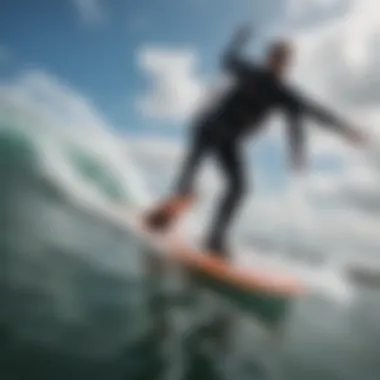

"A good kite, a solid board, and mindful attention to conditions can turn an average day into an unforgettable ride."
In summary, grasping the technological aspects of foilboard kitesurfing doesn’t just empower riders but also enriches the adventure we seek in the great blue beyond.
Advantages of Foilboard Kitesurfing
Foilboard kitesurfing is more than just a trend; it's a significant shift in the kiteboarding world. This section explores the benefits of this innovative sport, shedding light on why many kiteboarders are making the switch to foilboarding. Effectively understanding these advantages can elevate both performance and enjoyment.
Fluid Motion and Speed
One of the most notable benefits of foilboard kitesurfing is the fluid motion it offers. Riders often describe the sensation as gliding effortlessly over the water, akin to flying just above the surface. This is largely due to the design of the foil, which allows it to lift off the water with less resistance compared to traditional boards. As a result, the ride becomes smoother and faster.
"Once you lock into that glide, it feels like you’re cutting through butter—it's a whole new level of freedom on the water."
This speed factor isn’t just for thrill-seekers. It allows for quicker transitions between maneuvers and reduces the overall exertion needed to keep going, especially in variable wind conditions.
Performance in Low Wind Conditions
Foilboarding shines when the wind isn’t cooperating. Traditional kiteboarding can sometimes be a dicey game in light winds, often leaving riders frustrated. In contrast, foilboards excel during these conditions. Thanks to their lift efficiency, even a gentle breeze is enough to keep you cruising along smoothly. This includes winds that are commonly deemed too weak for standard boards.
Riders can often experience sessions that would otherwise be called off, making foilboarding not just an alternative, but a versatile tool for enjoyment on the water year-round. In places where conditions often fluctuate, this adaptability sets foilboard kitesurfing apart.
Reduced Environmental Impact
Finally, let’s touch on the environmental aspect of foilboarding. Unlike traditional methods of kitesurfing that often require bulky equipment, foilboards are typically lighter and have a smaller footprint. Less material means that the impact on natural environments is reduced. Additionally, the design of foilboards often maximizes efficiency, meaning less energy is required to maintain speed and momentum.
Through specific gear choices, riders can contribute positively to ecological conservation. As kitesurfers become more environmentally conscious, the reduced environmental impact of foilboarding can resonate well with the culture of outdoor enthusiasts.
In summary, the advantages of foilboard kitesurfing go beyond mere speed and maneuverability. They encompass an improved performance in various wind conditions and a commitment to environmental sustainability, making foilboarding a compelling choice for both newcomers and seasoned pros.
Challenges and Considerations
Venturing into the world of foilboard kitesurfing isn’t all about the exhilarating thrill of gliding atop the waters. It comes with its own set of challenges and considerations that any aspiring rider should be acutely aware of. Understanding these elements is crucial, as they directly influence one’s journey towards becoming adept at the sport. The learning curve, equipment costs, and paramount safety concerns are three critical areas that deserve thoughtful exploration. Each of these challenges presents both hindrances and opportunities for growth.
Learning Curve
Learning to foilboard can feel like trying to walk a tightrope while juggling flaming torches—daunting, to say the least. Unlike traditional kitesurfing, where the board remains firmly in contact with the water surface, foilboarding demands a new level of balance and coordination. Riders must find their footing in the air, relying on the foil to keep them elevated.
One of the biggest hurdles is getting used to the sensations of lift and descent. Beginners often struggle with how much pressure to apply on the board and when to lean back or forward. A common recommendation? Start practicing on flat water, as it makes the entire experience less nerve-wracking.
Moreover, it’s vital for learners to manage their expectations. Progress might seem slow initially, but with perseverance and practice, riders often find themselves gaining confidence and the necessary skills to master the art of foilboarding.
Equipment Costs
Investing in the right equipment for foilboard kitesurfing can feel like digging into one’s savings for that fancy new gadget everyone seems to have. The costs associated with this sport can be substantial, and it's essential to approach them with both realism and understanding. A new foilboard, a compatible kite, and other paraphernalia such as harnesses and safety gear can quickly add up.
- Foilboard Prices: Depending on the brand and specifications, you might be looking at anywhere from a few hundred to several thousand dollars.
- Kite Purchases: Kites also vary widely in price, often influenced by size and brand features.
That said, it’s often wiser to invest in quality over quantity. Custom packages and bundles can sometimes offer a more cost-effective alternative. Not to forget, many riders find value in second-hand gear—just make sure to check the condition before closing the deal.
Safety Concerns
Safety should be at the forefront of all foilboard kitesurfing endeavors. Riding in unfamiliar conditions or without proper gear can escalate risks significantly, making it critical for enthusiasts to prepare adequately.
Understanding Risks
Every sport has its risks, and foilboarding is no exception. The primary characteristic to keep in mind is the potential for falls. The elevated nature of foilboarding means that riders are prone to a unique set of accidents, some being more severe than those experienced in traditional kitesurfing. Those who are not cautious can easily find themselves caught up in hazardous situations, especially with changing wind or wave conditions.
Riders should continuously evaluate their surroundings, be familiar with prevailing weather patterns, and never shy away from respecting the power of nature.
Proper Safety Gear
Equipping oneself with the right safety gear is vital; it can be a game changer. A well-fitted helmet, impact vest, and appropriate wetsuit can mitigate some risks associated with foilboarding. The key characteristic that makes this gear indispensable is their ability to protect against falls and collisions, which are more likely at higher speeds and altitudes.
- Impact Vest: Helps absorb shock during falls, making it a popular choice.
- Helmet: Provides crucial head protection, especially for those still figuring out the nuances of balance.
Failing to wear proper safety gear can lead to increased injuries, leaving a rider to rue their choices. Investing in well-made, comfortable, and reliable protective gear not only enhances safety but also boosts confidence on the water.
Overall, tackling the challenges of learning, costs, and safety is not just about endurance but about strategy and preparation. With thorough understanding, riders can navigate these issues successfully and elevate their foilboard kitesurfing experience to new heights.
Selecting the Right Equipment
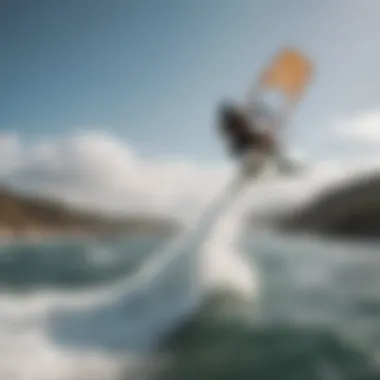

Choosing the right equipment is absolutely pivotal in the world of foilboard kitesurfing. A well-selected kite and board can mean the difference between a smooth experience on the water and an unnecessarily challenging one. It's not just about personal preference; it’s about understanding the dynamics of your gear and how it interacts with your riding style, skill level, and even the specific water conditions you'll encounter.
Selecting appropriate equipment ensures that riders can maximize their performance while staying safe. The right kite can harness wind energy effectively, while a suitable foilboard provides lift and stability.
Choosing the Proper Foilboard
Different Sizes and Shapes
When it comes to foils, the size and shape of the board are fundamental aspects that can influence your experience significantly. Boards come in various sizes—short, long, wide, or narrow—and each size offers distinct handling characteristics. For instance, longer boards can provide better stability and are generally preferred for beginners, while short boards allow for more agility, which is favored by advanced riders.
A unique feature of size variation is how it affects buoyancy. Larger boards float better, making it easier for new riders to get comfortable with balance, while smaller boards facilitate quicker maneuvers for experienced tasters of foilboarding. Choosing a size that aligns with your skill set can vastly improve your learning curve.
Material Considerations
Choosing the material of the board is just as crucial as its size. Boards can be made from various materials, with the most common being foam, carbon fiber, and fiberglass. Foam boards, for example, are lightweight and provide a cushioned feel, which can be a blessing for those just starting out. They tend to absorb impacts better, providing a more forgiving experience on the water.
On the other hand, carbon fiber boards are light and stiff, allowing for excellent performance but they often come with a higher price tag. It’s essential to weigh the benefits against your budget. Each material has its advantages and disadvantages. The right choice can enhance your performance and lifetime of enjoyment.
Kite Recommendations
Types of Kites
Kites designed for foilboarding differ widely from traditional kitesurfing kites. The major players in this game are inflatable kites and foil kites. Inflatable kites are popular for their versatility and stability in a range of wind conditions. They have a structure that supports itself with air, giving it robustness in higher winds.
Conversely, foil kites are more compact and can offer better performance in light winds. Their unique design uses a series of cells that fill with air to create lift. For riders focusing more on cruising and gliding quietly over tranquil waters, foil kites often come highly recommended. They provide excellent efficiency in exploiting varying wind conditions.
Size Appropriateness
The size of the kite you choose is vital and should reflect both your weight and the conditions you plan to ride in. Generally, larger kites capture more wind, ideal for lighter riders or those venturing into low wind zones. It helps to think of kite size in correlation with the experience level; beginners benefit from a kite size that provides ample lift without overwhelming power. Conversely, seasoned riders may opt for slightly smaller kites that offer increased maneuverability.
Remember that the local wind conditions are a key factor when determining what size kite is appropriate. A kite that works great in one area might perform poorly in another due to differing wind speeds and directions.
Choosing the right equipment is akin to having the right tools for a job. It’s imperative for kiteboarders—be it novices or seasoned pros—to scrutinize their options closely. In doing so, they can robustly equip themselves for the exhilarating challenges that await on the open waters.
Techniques for Mastery
Mastering the techniques of foilboard kitesurfing is crucial for anyone looking to truly enjoy and excel in this sport. Unlike traditional kitesurfing where the board is in contact with the water at all times, foilboarding involves a whole different game. Riders harness the power of their kite to lift above the water, navigating with finesse as they glide.
Learning the essential techniques not only enhances performance but also allows riders to explore the full potential of their equipment. It��’s about combining the right movements and adapting skills acquired from other forms of kiteboarding. As riders evolve, so too does their understanding of the necessary nuances that separate casual boarders from the serious ones.
Moreover, mastering these techniques unlocks a world of creativity on the water. Riders can start expressing their personal style through tricks and maneuvers, starting small and, with time, building up to impressive displays of skill.
Basic Riding Techniques
In the realm of foilboarding, having a solid grasp of basic riding techniques serves as the foundation for everything that follows. Balancing on the foil is quite different than riding a conventional board. Here are some core elements to keep in mind:
- Body Positioning: Keep your weight centered and lean slightly forward to maintain lift. This balance is critical; too far back, and you risk a nosedive.
- Engaging the Kite: Understand how to control the kite's pull to achieve desired speed and lift. Utilizing wind power effectively is a game-changer.
- Controlled Turns: Begin with smooth, gentle turns to get a feel for the foil’s response to your shifting weight. This builds confidence as you progress.
Practice these techniques repeatedly, as repetition helps develop muscle memory. The smoother these motions become, the more enjoyable and effortless your riding will seem.
Advanced Maneuvers
Once the basics are under control, aspiring foilboarders can explore advanced maneuvers that not only showcase skill but also enrich the riding experience. These techniques often require both courage and finesse, combining a range of body movements with precise kite control.
Jumping Techniques
Jumping techniques are a standout feature of foilboarding. They allow riders to take flight, literally, which can be exhilarating. This technique isn’t just about going up; it’s an art form. Riders often find joy in the sensation of lifting off the water and soaring through the air. Key characteristics include:
- Timing: The ideal moment for takeoff hinges on the kite's position and wind strength. The sweet spot is crucial for a successful jump.
- Body Mechanics: Engaging your legs and core converts your lift into a controlled ascent. It’s not simply about yanking the kite; it’s about finesse.
Highlighting its unique feature, jumping allows riders to express creativity while also pushing personal limits. It’s no wonder this maneuver is a beloved aspect of foilboarding. However, disadvantages include potential landing issues and the risk of wipeouts, especially when starting out. Thrilling, yes, but it demands respect.
Turning and Transitioning
Turning and transitioning can transform an ordinary ride into an impressive display of skill. This maneuver involves shifting your weight efficiently to redirect the board without losing speed or control. Key characteristics include:
- Flow: Seamless transitions enhance the overall aesthetic of your ride. Riders who master this skill appear to glide effortlessly.
- Strategic Use of the Kite: Effective use of the kite during turns is fundamental. Timing and positioning significantly impact how smooth your transition will be.
The unique feature of these techniques is the requirement of spatial awareness. It's not just about physical movement; you must keep an eye on the wind and water conditions. Properly executed turns can lead to surprising gains in speed and performance. On the downside, improper technique can lead to difficult recoveries from dips in speed, particularly in choppy waters.
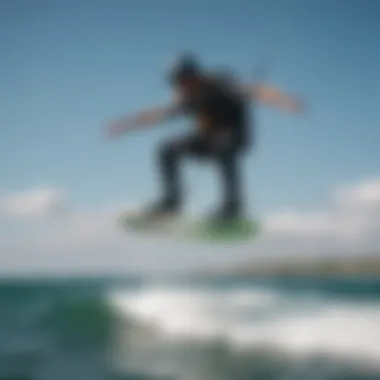

With every turn, jump, and transition, riders become not just participants but artists on the water, continually evolving their style in the captivating world of foilboard kitesurfing.
"Mastering the techniques in foilboarding isn’t just an exercise in skill; it’s the gateway to unearthing the fullest potential of the ride."
For those looking to dive deeper into the community and share experiences, various online platforms like reddit.com provide valuable insights and camaraderie among riders sharing tips and stories.
Optimal Settings for Foilboarding
Finding the right conditions to engage in foilboarding can make or break your experience on the water. Unlike traditional kitesurfing, foilboarding demands specific elements to function optimally. In this section, we will delve into various aspects of foilboarding’s environmental settings, focusing on location choices and seasonal considerations that are essential for maximizing enjoyment and performance in the sport.
Ideal Locations
Coastal Areas
Coastal areas are often lauded as the playgrounds for foilboarders. One of the main characteristics of these locations is the vast expanse of open water which provides ample room to maneuver. The presence of consistent wind patterns and waves can be particularly beneficial, enhancing the thrill of riding and allowing for smooth transitions from riding to aerial maneuvers.
However, it's not all sunshine and rainbows; coastal conditions can vary greatly. The tides can be unpredictable, and strong currents pose a challenge. Still, the advantages far outweigh the downsides. Riders can often find schools or local communities where they can connect and share tips, making it easy to pick up new techniques and tricks.
"The coastline really opens up a world of possibilities for foilboarders, but staying safe means knowing the conditions and planning accordingly."
Lakes and Flat Water Spots
Lakes and flat water spots cater to those who prefer steadier environments for foilboarding. One key feature of these locations is their generally calmer waters, which make it easier to learn and practice various techniques without the added complexity of waves and strong currents. This gives both beginners and seasoned riders a chance to hone their skills in a more controlled setting.
The glassy surface of lakes provides exceptional lift and stability, allowing for longer rides and smoother landings. However, flat water spots might suffer from unforeseen gusts or changes in wind strength, which may disrupt your session. Still, lake environments tend to have lower crowds compared to coastal areas, offering a more serene experience for those who seek it.
Seasonal Considerations
Timing can be everything when it comes to foilboarding. Each season presents unique opportunities and challenges. In certain areas, spring and fall can provide optimal wind conditions, whereas summer can bring about flat water reserves that enhance riding experiences. During these transitional periods, the wind may be more reliable and consistent, making for more enjoyable outings.
Weather patterns also dictate the best times to foilboard. Keeping an eye on forecasts, and local kiting events can help riders plan their trips accordingly. Understanding the climate in your chosen location enables riders to take full advantage of nature’s offerings while ensuring a safer experience.
Community and Culture of Foilboard Kitesurfing
The community and culture surrounding foilboard kitesurfing is like a tapestry crafted from diverse experiences, shared passions, and the ultimate quest for adventure. It's not just a sport; it's a lifestyle that gathers enthusiasts from various backgrounds, blending their stories into one dynamic experience. This sense of belonging among riders isn't just essential; it fortifies the essence of foilboarding itself.
Kiteboarding Events and Competitions
Kiteboarding events and competitions serve as pivotal moments for the community, acting like magnets that draw individuals with a shared love for the sport. These gatherings not only showcase top-tier talent but also foster camaraderie.
The thrill of watching expert foilboarders perform – their precision and artistry on the water – ignites inspiration among beginners and seasoned riders alike. Events like the The IKA World Kiteboarding Championships happen annually, drawing thousands of spectators and participants. There’s always something electrifying in the air, whether it's a local competition at a favorite spot or a major international event.
Participation in these events allows riders to learn new techniques, share tips, and connect over their love of the sport. They also present fantastic platforms for brands to demonstrate innovative products, which is helpful for anyone looking to purchase gear.
Online Communities and Resources
In this digital age, the online presence of foilboard kitesurfing is vibrant and ever-growing. Websites, forums, and social media platforms serve as invaluable resources for enthusiasts. Reddit and Facebook host groups where members exchange insights, photos, and experiences, creating a virtual space where everyone can feel included.
The depth of information available online can be overwhelming, but it also provides excellent opportunities for learning. Tutorials on YouTube can guide aspiring riders through the nuances of various techniques.
Many prominent brands in the industry maintain a robust online presence, offering tips and connecting users with local events. Engaging with fellow riders through these platforms not only enriches knowledge but also strengthens connections, turning casual friendships into life-long bonds.
"The thrill of foilboarding is best experienced in the company of fellow enthusiasts who understand exactly what it's about. Whether it’s sharing tips, tricks, or just a few laughs, it’s a journey we take together."
Through events and online engagements, the culture of foilboard kitesurfing flourishes, bridging distances and transforming individual pursuits into a collective movement. Each experience shared fuels the passion of this unique community, ensuring that foilboarding continues to evolve and inspire.
Future of Foilboard Kitesurfing
The evolution of foilboarding isn't just a trend; it's a growing movement that's reshaping the landscape of kitesurfing. As kiteboarders seek new adventures and ways to enhance their skills and experiences, the future of foilboard kitesurfing appears quite bright. This section examines emerging trends and innovations in the equipment design, which provide insights into the potential trajectories of the sport.
Emerging Trends
In recent years, several trends have started to take root in the foilboarding community. These trends signal not just the popularity of the sport, but also how enthusiasts are pushing the boundaries of what's possible on the water.
- Increased Accessibility: Manufacturers are developing more user-friendly products that cater to beginners. This means that more people can join in, widening the community. For instance, gear that combines performance with stability enables novices to learn without feeling overwhelmed.
- Sustainable Practices: There's a noticeable shift toward eco-friendly materials and practices in the production of foilboarding gear. Companies are discovering how to balance high performance with environmentally conscious choices—like using recycled plastics in boards or natural resin.
- Safety Innovations: With the sport’s growth, the focus on safety has become paramount. Enhanced safety features include improved binding designs and emergency release systems that help protect riders, especially those who are just starting out.
These trends are not just passing fancies; rather, they represent a meaningful shift in a sport that encourages exploration and creativity.
Innovations in Equipment Design
The design of foilboarding equipment constantly pushes the envelope of innovation. Current developments suggest a promising future as engineers and designers delve into new ideas and materials.
- Lightweight Materials: The use of advanced composites is becoming mainstream, allowing for boards that are not only lighter but also more durable. This means riders can enjoy better control and maneuverability on the water. Brands like Naish and Slingshot are leading the charge in incorporating these materials into their designs.
- Enhanced Foil Technology: The development of adjustable foils has been a game-changer. Riders can modify their setups based on conditions, allowing for a personalized experience. Adjustability also permits versatile use, from cruising to jumping, catering to different levels of expertise.
- Integrated Smart Technology: Some of the latest prototypes are including tech features that can measure performance metrics like speed and height. Coupled with smartphone apps, this innovation allows kitesurfers to track their progress and set personalized goals.
"Foilboarding is rapidly advancing, and those who embrace these changes will find themselves at the forefront of a thriving watersport community."
All these innovations embody a spirit of creativity and ingenuity that continues to forge new paths in foilboard kitesurfing. As we move forward, the sky—quite literally—remains the limit.




